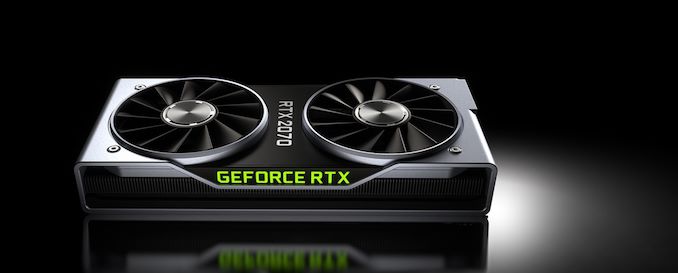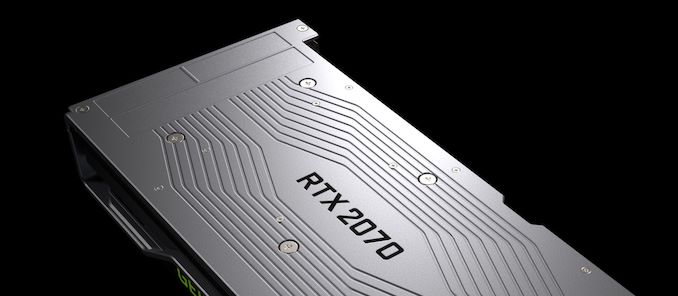The NVIDIA GeForce RTX 2070 Founders Edition Review: Mid-Range Turing, High-End Price
by Nate Oh on October 16, 2018 9:00 AM ESTFinal Words
As we wrap up, it’s clear that judging the RTX 2070 involves the same themes that surfaced in the RTX 2080 Ti and 2080 review. First is for the forward-looking featuresets that have yet to publicly launch. Another, and closely intertwined, is the premium pricing that is based on those features, as opposed to being based on conventional gaming performance. And lastly is the existing competition in the form of Pascal, especially where the RTX cards fall in the same performance tier.
For the RTX 2070 Founders Edition, those themes are more relevant and harder to dismiss. By its nature, the card is an entry-level model for consumers interested in real time raytracing and other RTX platform features, as well as the traditional high-end card for prospective enthusiasts and upgraders on a budget. In the past couple generations, these ‘enthusiast value’ parts have essentially provided last-gen flagship performance (or better), at non-flagship prices. For example:
- GTX 1070 for GTX 980 Ti
- GTX 970 for GTX 780 Ti
- GTX 770 refresh of GTX 680
- RX 580/480 for R9 390
- R9 390 refresh of R9 290
- R9 280X refresh of HD 7970
Going back to the numbers, the RTX 2070 Founders Edition TDP and boost clock tweaks only amount to around a 4% gain over the reference 2070 at 4K. The difference is not much in the grand scheme of things, but the setup makes more sense when looking at the GTX 1080 competition. The reference RTX 2070 is faster than the GTX 1080 at 4K and 1440p by only around 10%, a gap that is easily closed by factory-overclocked custom cards.
By hardware resources, the RTX 2070 was expected to be around 75% of the 2080. But Founders-to-Founders and reference-to-reference, the RTX 2070 is bringing around 83% of the RTX 2080’s 1440p performance (and 82% of 4K performance). So the performance gap is comparable to previous generations, where the GTX 1070 brought 81% of the performance of the GTX 1080, and the GTX 970 brought 87% of the GTX 980. Except here the RTX 2080 is only managing GTX 1080 Ti level performance for traditional gaming.
Looking back at the Pascal launch, the GTX 1070 brought a 57% 1440p performance gain over GTX 970, which was substantive but with its $450 Founders Edition pricing, not necessarily a must-buy for GTX 970 owners. On the other hand, GTX 770/670 owners had a lot to gain from that upgrade.
Here with Turing, the RTX 2070 is ahead of the GTX 1070 reference-to-reference around 35% and 36% at 1440p and 4K, respectively. In its Founders Edition guise, the difference is around 41% for both resolutions. Either way, the performance lies somewhere between the GTX 1080 and 1080 Ti, except with a $600 Founders Edition price. In that sense, it offers less than last generation but at a higher price, the premium being tied to real time raytracing and other hardware-accelerated features. And when those features finally release, there's no clear sense of the quality or resolution compromises necessary to run those features.
For current GTX 10 series owners, the RTX 2070 is largely a side-grade, offering known performance for possibily worse power efficiency. For those with low-end cards, or 900 series and older products, the $500/$600 budget pulls in a number of other alternatives: the GTX 1080, RX Vega 64, or even the GTX 1070 Ti. As far as standard $500 MSRP pricing goes, for which some cards are priced so currently, it helps the RTX 2070 stay in the price/performance race, where at $600 that might be a $100+ premium over a competing product. In particular, the sub $500 GTX 1080 cards are a major spoiler for the RTX 2070, offering equivalent performance at lower price. A prospective RTX 2070 buyer will have to be honest with themselves on utilizing RTX features when the time comes, and any intentions they might have on upgrading monitors for HDR, higher resolution and/or refresh rate, and variable refresh rate technology.













121 Comments
View All Comments
PeachNCream - Tuesday, October 16, 2018 - link
You've got a good graphics card in the 970 that should get you at least a couple more years of reasonable performance. If I were in your position, I wouldn't be in the market for a new GPU. However, I do sympathize with you when it comes to the cost it takes to be able to play these days and I agree that a shift to some form of console is a sensible alternative. PC hardware pricing has been on the rise in the last few years and it stings when you've come to expect performance improvements alongside cost reductions that we've been enjoying for the majority of the years since microcomputers found their way into homes in the 1980s.I think what's driving that is a diminishing market. Economies of scale don't work when there's no further growth for what's become a mature industry (PCs in general) and a declining segment (desktop PCs in specific) due to the slow shift of computing tasks to mobile phones. I don't see anywhere for desktop components to go but further up as we lean into the physical limits of the materials we have available while also contending with falling sales numbers. Compound that with the damage these prices will inflict on the appeal of PC gaming to the masses and we're starting to look at a heck of an ugly snowball on its way down the hill.
It's probably a good time to make a graceful exit like you're mulling over now. As someone else that's thrown in the towel, I can happily confirm there's lots of fun to be had on very modest, inexpensive hardware. From older games to low system requirements new releases, I have faith that there will always be a way to burn up a lot of free time at a keyboard even if you end up with very old, very cheap hardware.
WarlockOfOz - Wednesday, October 17, 2018 - link
Concur. I'm still rocking a 750Ti and feeling no need to upgrade it or the even older CPU (phenom x4) despite having money put aside. I'll replace when it breaks, like my fridge, unless something does make going past 1080p compelling - whether that's VR, ray tracing, or a must have game that I can't play at all.nikon133 - Tuesday, October 16, 2018 - link
I hear you.Been considering to make my current rig - older i7 (Haswel) with recently added 1070 - my last gaming PC. It really boils down to how next gen consoles turn out - but even as current gen is, I seem to be spending more time on PS4 than on gaming PC. In fact, MHW is the only game I am playing on PC atm, and event hat because of friends who insisted to play it on PC. Eventually, we are lucky if we get to play it together once a week, on average... definitely not worth investment into new rig, for me.
ingwe - Wednesday, October 17, 2018 - link
I mean you don't need the most top end or recent parts. I am gaming on a 5850 and i5-4670K (I think that is the model it has been so long I might be mixing things up). It runs great. 256 GB SSD and 16 GB of ram.The prices are crazy for the high end but you also don't need the highest end and most recent gen when performance improvements are marginal.
Farfolomew - Monday, October 22, 2018 - link
In the 486 days, computer gaming was worth that much money. The landscape was rapidly changing, games were rapidly changing. The internet was taking hold, 3D gfx starting to be born. It was amazing. It was money well spent to be able to play groundbreaking new types of games.Nowadays, although overall less expensive perhaps, your money doesn't buy you much new in terms of originality and exciting gameplay. All we get are prettier and prettier textures with duller and duller games. WoW and Counterstrike are STILL massively popular games, certainly not for their gfx.
Eris_Floralia - Tuesday, October 16, 2018 - link
Nate, iirc they handicapped the tensor performance of FP16 with FP32 accumulate, which is only half of those on equivlant Quadro cards, maybe that's why HGEMM performance is low.https://cdn.discordapp.com/attachments/47593159264...
Eris_Floralia - Tuesday, October 16, 2018 - link
*equivalentYojimbo - Tuesday, October 16, 2018 - link
The chart says half precision GEMM. So I think a lack of accelerated 32-bit accumulation should not be slowing the GPU down. As far as I know, the Turing Tensor Cores perform FP16 multiplications with FP16 accumulations at 8 operations per clock much like Volta Tensor Cores perform FP16 mults. with FP32 accumulation at 8 operations per clock.Eris_Floralia - Tuesday, October 16, 2018 - link
Turing FP16 with FP16 accumulate is fully enabled on all RTX cards, but FP16 with FP32 accumulate is 1/2 rate on GeForce cards.They used out of the box configuration which likely used Volta's FP16 with FP32 accumulate, resulting in half the performance.
HGEMM results for 2080TI/2080/2070 are very close to their 54/40/30 TFLOPS theoretical performance. If it was a Quadro card you will see double the performance with this config. If they updated the binary support, you'll likely see double the perf with FP16 accumulate too.
Yojimbo - Tuesday, October 16, 2018 - link
"They used out of the box configuration which likely used Volta's FP16 with FP32 accumulate, resulting in half the performance."It could be some driver error. But I don't see why the GPUs not having FP32 accumulate should be the ultimate cause for the poor results. I admit I don't know much about the test, but why should the test demand FP16 multiplications with FP32 accumulate? That's more or less an experimental situation only available commercially in NVIDIA's hardware, as far as I know. If the test is meant to use FP16 accumulate and FP32 is being forced in the test then the reason for the poor results is a driver or testing error, not that Turing GPUs only have FP16 accumulate at full Tensor Core speed for the precision.